The Calculating Beauty of Butterflies
How butterflies' colorful wing patterns help them hide, lie, and impress the ladies.
More on Discover
Stay Curious
SubscribeTo The Magazine
Save up to 40% off the cover price when you subscribe to Discover magazine.
Subscribe












